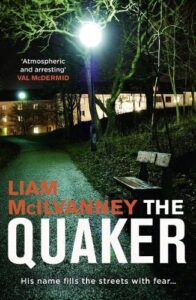by Liam McIlvanney; reviewed by Jeannette Hartman
 Detective Inspector (DI) Duncan McCormack thinks of himself as a thief-catcher. His boss thinks of him as an up-and-coming young man who might be grateful for a boost up the ladder.
Detective Inspector (DI) Duncan McCormack thinks of himself as a thief-catcher. His boss thinks of him as an up-and-coming young man who might be grateful for a boost up the ladder.
The opportunity being dangled before McCormack is to be an independent police officer reviewing activity in a serial murder investigation.
The job entails two things: Make sure nothing has been missed that could move the case forward, and then write a report justifying winding the case down.
The case involves the murders of Jacquilyn Keevins, Ann Ogilvie and Marion Mercer. They had little in common except they had gone dancing at the same ballroom. There, each had met a quiet, well-dressed, well-spoken man; and been found battered and assaulted in tenement alleys the following day.
The department gave the case a high media profile and invited citizens to come forward with any information. Months later, they had nothing to show for it.
“The brass had lost their heads. They’d thrown so much money at this, poured so many man-hours into a holey bucket, that they didn’t know how to stop.”
Duncan, who would much rather have been working on a recent jewelry heist, walks into the Murder Room hated by every detective present. He comes to believe the killer has moved out of the area. Just as he turns in his report to that effect Marion Mercer is killed.
As he pours over the files and partners with the slowly thawing detective Derek Goldie, Duncan finds himself increasingly obsessed with the case.
Set in Glasgow in 1969, the story is loosely based on the real-life, still uncaught, serial murderer Bible John. This case was the first time in which the Crown Office allowed a composite drawing of an individual suspected of murder to be released to the public.
Some believe that convicted serial killer and rapist Peter Tobin, whose movements and methods fit those of Bible John, may have been Bible John. That has never been confirmed.
McIlvanney has written an atmospheric police procedural that reflects the turbulent social and economic times combined with intense urban renewal in that period of Glasgow’s history. He moves the story from a murder mystery to a thriller of proportions that became increasingly difficult to believe.
About the Author: Liam McIlvanney
Born in Scotland, Liam McIlvanney now teaches in the Department of English and Linguistics at the University of Otago, New Zealand. He is the inaugural holder of the Stuart Chair in Scottish studies at Otago.



